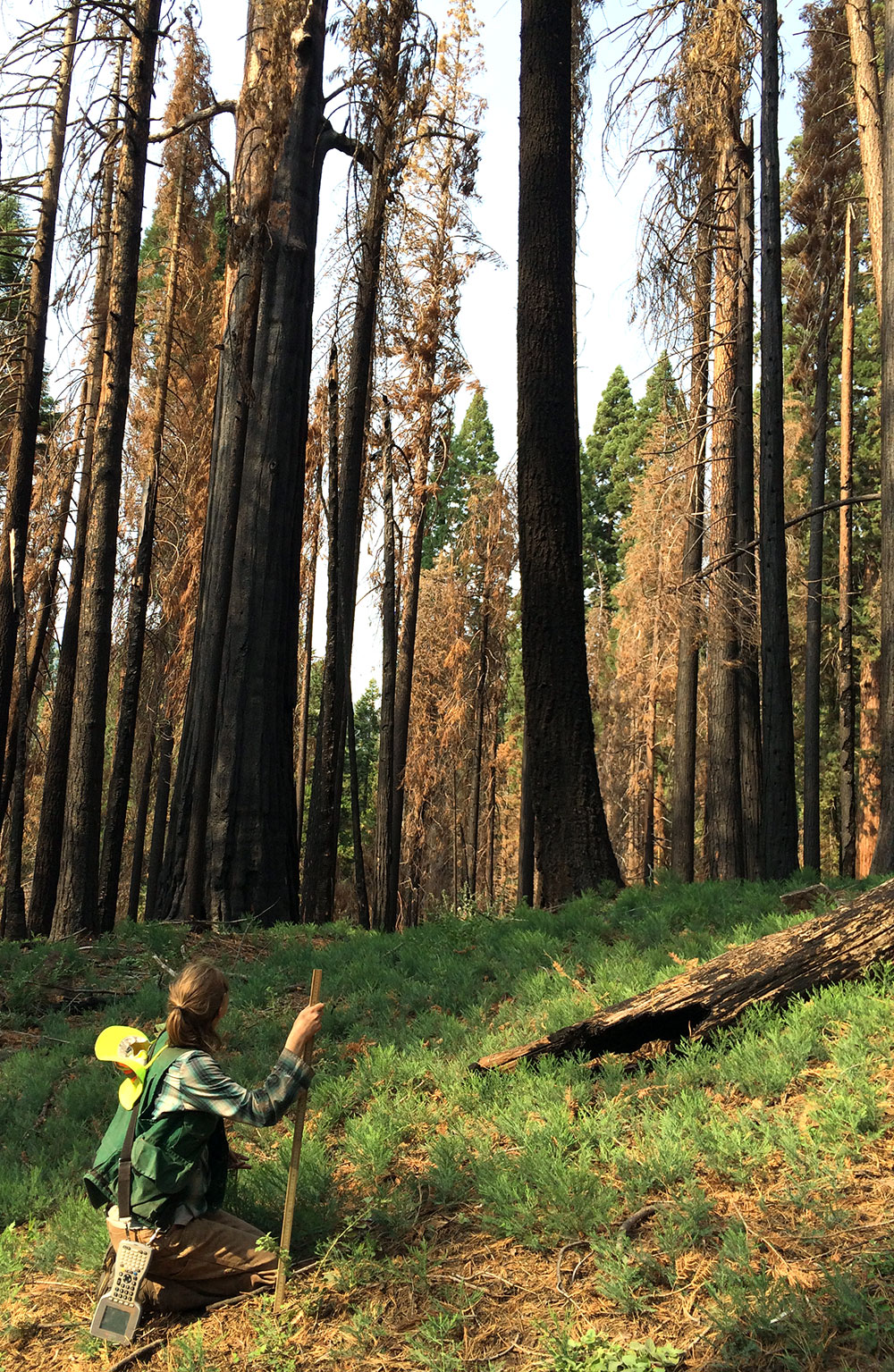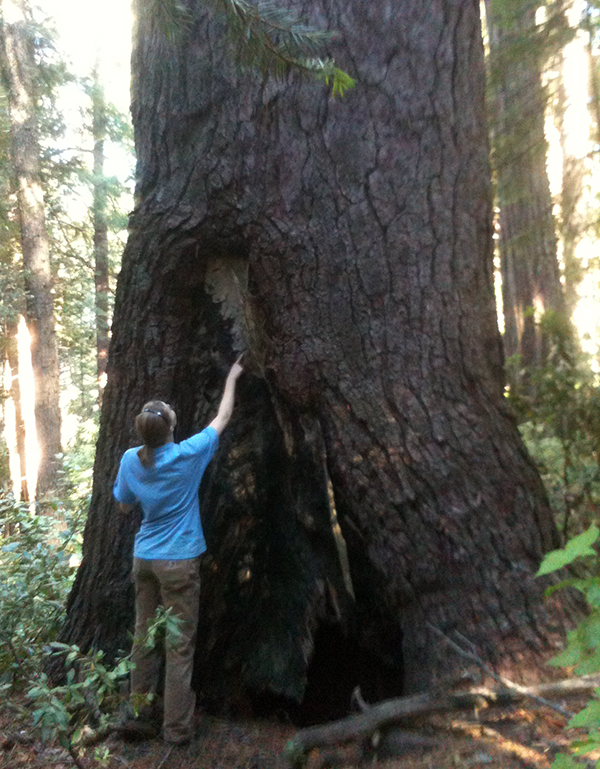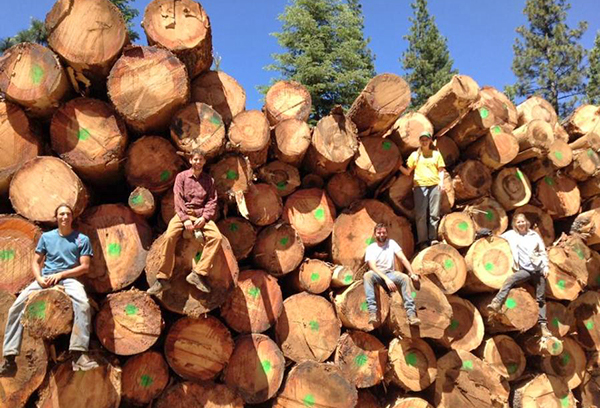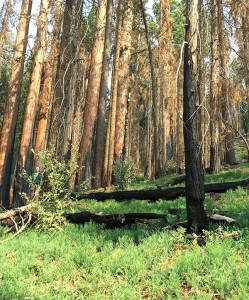By Robin Bellows, ESPM Graduate Student, Master of Forestry

Photos courtesy of Julian Bauer and Robin Bellows.
At the end of a long day in the woods, my field partner and I stumbled into a sight both tragic and inspiring: a graveyard of giant trees. Five majestic sequoias, hundreds if not thousands of years old, had succumbed to the joint stresses of fire and drought. Their fate was formed not by age alone, but rather by the legacy of human impacts on the land: historic sequoia timber cutting, preservation in parks, wildland fire politics, and scientific progress that rewrote our understanding of fire in forest ecosystems.
I’d spent the day searching for fuzzy, blue-green seedlings as part of a study on elusive giant sequoia regeneration. Mature sequoias are among the most massive living organisms on earth, sometimes growing hundreds of feet tall and wide enough to encompass a car or small cabin. They occur naturally in only a handful of groves across the Sierra Nevada. Young sequoias are especially rare, and their ecology is not fully understood.Several years after a prescribed fire, we were counting sequoia seedlings sprouting in newly formed canopy gaps in order to see if these conditions promoted seedling establishment. A good plot held a handful of seedlings. More than a dozen was cause for excitement. These infant trees will face many challenges in their long lives. As well as a gamut of insects, disease, weather, and fire, the seedlings now occupy a forest structure that may have changed dramatically from the landscapes of their ancestors. Climate change compounds other environmental change, from landscape conversion to invasive species to the frequency and intensity of fire.
As a master of forestry student at Berkeley, I feel lucky to study ecological and human elements of land stewardship alike. Our environmental problems are increasingly complex, but so is our understanding of the natural world around us. I believe that fundamental research and applied land stewardship techniques both play a role. Without research, management may not be scientifically credible and may have an increased chance of causing unintended harm. Without practitioners putting new knowledge into practice, advances in our understanding of ecological systems may never translate into conserved, restored, or even utilized resources.

The challenges we face today have so many sides to them: ecology, policy, aesthetics, rural and urban politics, modeling, management… this list could go on forever. University of California research forests hold a special position in addressing these issues because they stand right at the junction of research and application. At Blodgett Forest Research Station, research takes place within and across active forest management units. New ideas about land management approaches can be tested and monitored on the ground, including invasive species control, fire management, and timber harvest practices. Sacramento lawmakers can access examples of forest management to assist in assessing new regulations. Students can take in the emotional impact of a clearcut, practice calculating forest management plans, contribute to research, and still admire soaring trees. “It’s a sampler palette of forestry,” said one student on a class field trip, “Where else do you see so many forest management types side by side?” Last summer, working at Blodgett was an opportunity to get my boots in the mud and put classroom concepts to practice, from timber management to resilience ecology. In class, I studied how stands of trees change over time; at Blodgett, I thinned young trees to manipulate the growth progression of the forest. I read about fire ecology in class, and at Blodgett I measured sapling survival after a burn. After hefting a pack full of frothy purple herbicide up a hill, I learned to respect its power in beating back thorns that would have taken hours of scratches to uproot by hand. I felled a tree and thought, “what responsibility do I have to reshape this landscape?”

The Blodgett summer crew, learning about timber harvesting. Photo courtesy of Blodgett Forest Research Station.
The Blodgett field crew sometimes started before dawn to escape the heat of the day. We counted time in jolly ranchers: the more difficult a task, the more jolly ranchers one could eat before finishing. We caught our breath at surprise moments of hidden beauty: a bower of roses in a sunbeam, woodpeckers winging through the trees, majestic old trees soaring up from dense thicket, huckleberries, the dark glint of a broken arrowhead. I had countless spider webs in my face. After a few months, I gained a more visceral understanding of different perspectives on forestry. I can only hope that, after finishing my degree, I can practice these joint tools of science and applied forest management to shape an ecologically and economically resilient forest. Research forests certainly do not have all the answers. But they do have many questions carefully written into experiments across the landscape. Just down the road from where we worked, within sight on neighboring ridges, everything was dead brown and charred black. The King Fire had burned so close that Blodgett was evacuated while fire containment lines were bulldozed across the forest. The threat of a nearby fire underscores how special a resource these research forests can be.

Sequoia regeneration research is a SPUR project with Rob York and Julian Bauer
It was humbling to discover the dead sequoias that day, but we were also surprised and awed by the rest of the scene: a carpet of green surrounded the bases of the dying giants. Cheerful sequoia seedlings covered bare soil in every direction, packed practically on top of one another, and even peeked out from under logs. The death of the old sequoias had formed a large opening in the forest. This gap was full of not handfuls, nor dozens, but rather thousands upon thousands of baby sequoias. (We spent hours counting more than seven thousand in one area!) The fire and drought were tragic, but also transformative. The future sprouted among the ashes.
